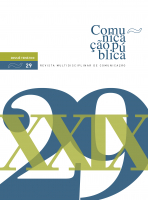The importance of waiting rooms for health literacy and communication
development of an instrument and analysis of patients’ perspectives
DOI:
https://doi.org/10.4000/cp.11337Keywords:
waiting room, health literacy, health education, health promotion, communicationAbstract
This paper discusses the potential of waiting rooms and circulation areas in ACES – Health Center Cluster Units, which henceforth will only be mentioned as “health units”, as privileged spaces for health promotion and for increasing health literacy. In a firstphase, an instrument of exploratory, qualitative, descriptive analysis was developed and applied in five health units. In the second phase, semi-structured interviews were applied to 45 patients of health units. These interviews collected patient’s opinions, perceptions and attitudes about the waiting room and its facilities and the attitudes towards health information shared in these spaces.
This work offers a holistic perspective based on direct and indirect observation of waiting room spaces in health units. An instrument that intends to work as an internal tool to support the self-management and continuous improvement of the quality of waiting spaces is available in this work.
Downloads
References
Almeida, C. V. (2020). Modelo de comunicação em saúde – ACP. Revista ENFormação, 10, 20-22.
Araújo, F. (2016). Sessão de abertura. In Conferência Percursos de vida, literacia em saúde, integração de cuidados - Reformas de proximidade, Lisboa
Clapton, G., & Reid, L. (2017). Neglected spaces: UK general practice surgery waiting rooms. BJGP Open,1(1). https://doi.org/10.3399/bjgpopen17X100641
Cockington, R. (1995). Health promotion using television in hospital waiting rooms: The Adelaide Children’s Parent Education Project. Journal of Pediatric Child Health, 31, 523–526. DOI : 10.1111/j.1440-1754.1995.tb00876.x
Direção-Geral da Saúde (2013). Conforto nas unidades hospitalares: Norma de orientação clínica nº 021/2013, de 31/12/2013. Lisboa: DGS.
Ekman, P. (1999). Facial expressions. In T. Dalgleish & M. J. Power (Eds.), The handbook of cognition and emotions (pp.301-320). New York: John Wiley & Sons.
Ekman, P., & Friesen, W. V. (1975). Unmasking the face: A guide to recognizing emotions from facial clues. Englewood Cliffs: Prentice-Hall.
Goelitz, A., & Kahn, A. (2008). Therapeutic use of space: One agency’s transformation project. Journal of Creativity in Mental Health, 2(4), 31-44.
Institute of Medicine (US) Committee on Health Literacy, Nielsen-Bohlman, L., Panzer, A. M., & Kindig, D. A. (Eds.). (2004). Health literacy: A prescription to end confusion. Washington: National Academies Press.
Khan, M.A., Shah, S., Grudzien, A., Onyejekwe, N., Banskota, P., Karim, S., Jin, J., Kim, Y., & Gerber, B. (2011). A diabetes education multimedia program in the waiting room setting. Diabetes Therapy, 2, 178 - 188.
Kickbusch, I., Wait, S., & Maag, D. (2005). Health literacy call. Report from Healthy Choices Forum at the 8th European Health Policy Forum.
Ministério da Saúde (2006). Orientações para instalações e equipamentos para unidades de saúde familiar. Lisboa: Direção Geral das Instalações e Equipamentos da Saúde - Ministério da Saúde.
Nutbeam, D. (2008). The evolving concept of health literacy. Social Science & Medicine, 67, 2072-2078, doi: 10.1016/j.socscimed.2008.09.050.
Paakkari, L., & Paakkari, O. (2012). Health literacy as a learning outcome in schools. Health Education, 112 (2), 133-152. doi:10.1108/09654281211203411.
Serviço Nacional de Saúde (SNS, 2016). SNS+ Proximidade; Mudança centrada nas pessoas. Lisboa: Serviço Nacional de Saúde. Disponível em https://s-1.sns.gov.pt/sns-mais/sns-proximidade-sobre/
Sherwin, H., McKeown, M., Evans, M., & Bhattacharyya, O. (2013). The waiting room “wait”: from annoyance to opportunity. Canadian Family Physician, 59(5):479-81. PMID: 23673581; PMCID: PMC3653648.
Sørensen, K., Van den Broucke, S., Fullam, J., Doyle, G., Pelikan, J., Slonska, Z., & Brand, H. (2012). Health literacy and public health: A systematic review and integration of definitions and models. BMC Public Health 12(80). https://doi.org/10.1186/1471-2458-12-80
Soussou, R., Aleksejūnienė, J., & Harrison, R. (2017). Waiting room time: An opportunity for parental oral health education. Canadian Journal of Public Health, 108(3), e251-e256. DOI : 10.17269/CJPH.108.5984
Zarcadoolas, C. Pleasant, A., & Greer, S. D. (2006). Advancing hHealth literacy: A framework for understanding and action. São Francisco: Jossey – Bass.
Downloads
Published
Issue
Section
License
Copyright (c) 2020 Direitos de Autor (c) 2020

This work is licensed under a Creative Commons Attribution-NonCommercial 4.0 International License.
Os conteúdos da Comunicação Pública estão licenciados com uma licença Creative Commons - Atribuição-NãoComercial 4.0 Internacional.


